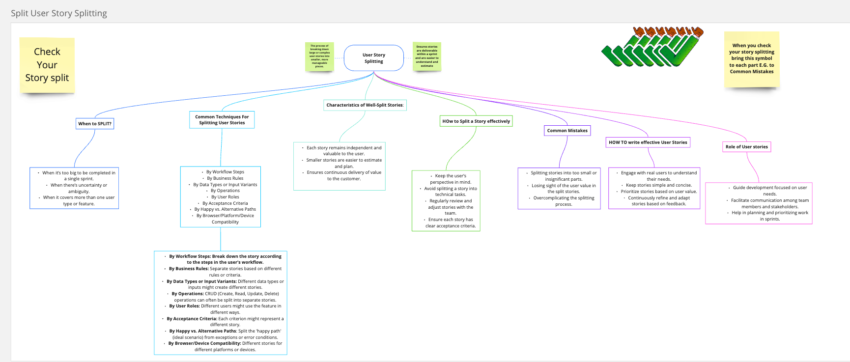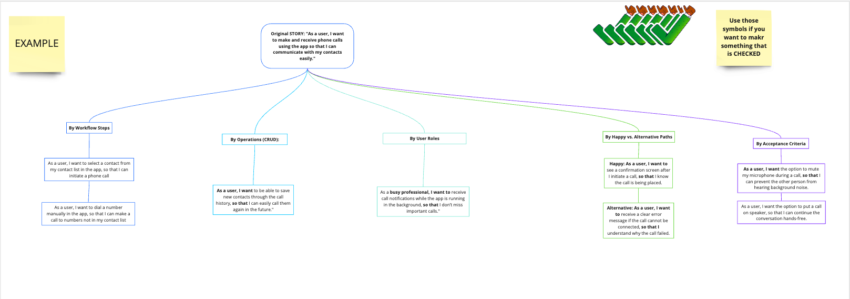Agile Adventures: Mastering the Art of User Story Splitting – One Slice at a Time!
User Stories Splitting – How would I explain this concept in Elementary School?
Think of a giant pizza – it’s too big to eat in one bite, right? That’s a big task in app development. So, what do we do? We slice it into smaller, bite-sized pieces!
We have something called ‘User Story Splitting’ in the tech world. It’s like taking a huge, complicated thing you want your app to do and breaking it down into mini-tasks. Why? Because tackling a whole bunch of small tasks is way easier than wrestling with one big, scary one.
Imagine you’re making an app that’s supposed to be the next big thing in phone calls. Instead of saying, “Let’s build an app that does everything with calls,” you break it down. One slice might be, “Let’s make a screen where you pick who to call.” Another could be, “Add a cool button to mute the call.”
It’s all about making things less overwhelming and more “I got this!” It’s fun – like turning a big puzzle into smaller, easy-to-solve pieces. So, next time you think about building something big, remember to slice it up, tackle it piece by piece, and watch your mega project become a bunch of easy tasks!

User Story Check list by Mark V. Smetanin
So, what are USER Stories?
User stories are simple descriptions of a feature from the user or customer’s perspective. They typically follow a simple template and are designed to keep the focus on user needs during the development process.
Now let’s create a basic User Story Cheat Sheet:
1. Definition of a User Story:
- A short, simple description of a software feature from the end user’s perspective.
- Emphasizes the user’s needs and why rather than how it will be implemented.
2. Standard Format:
- As a [type of user], I want [an action] so that [a benefit/value].
- Example: “As a frequent shopper, I want to filter search results by price range to find products within my budget.”
3. Key Components:
- Role (Who): The type of user or persona.
- Goal (What): What the user wants to achieve.
- Reason (Why): The benefit or value to the user.
4. Characteristics of a Good User Story (INVEST):
- Independent: The story can be developed in any sequence and is not dependent on other stories.
- Negotiable: Open to discussion and changes.
- Valuable: Provides value to the end user.
- Estimable: Small enough to be estimated and planned.
- Small: Can be completed within a sprint.
- Testable: Clear acceptance criteria to determine when the story is completed.
5. Acceptance Criteria:
- Specific conditions must be met for the story to be considered complete.
- Guides development and testing.
6. Common Mistakes:
- Writing too detailed or technical stories.
- Ignoring the user’s perspective.
- Creating overly large or vague stories.
7. Tips for Writing Effective User Stories:
- Engage with real users to understand their needs.
- Keep stories simple and concise.
- Prioritize stories based on user value.
- Continuously refine and adapt stories based on feedback.
8. Role of User Stories in Agile:
- Guide development focused on user needs.
- Facilitate communication among team members and stakeholders.
- Help in planning and prioritizing work in sprints.
This cheat sheet serves as a quick reference for teams to ensure they are creating effective and valuable user stories that genuinely reflect the needs and desires of their users. It’s important to remember that user stories are not static and may evolve as more is learned about user needs and project constraints.
So, How do We SPLIT user stories?
The story-splitting process involves outlining techniques and guidelines for breaking down large, complex user stories into smaller, more manageable ones. This process is essential in agile development to ensure stories can be completed within a single sprint and are clear and testable.
Here’s a basic outline for a User Story Splitting Cheat Sheet:
1. Definition of User Story Splitting:
- The process of breaking down large or complex user stories into smaller, more manageable pieces.
- Ensures stories are deliverable within a sprint and are easier to understand and estimate.
2. When to Split a User Story:
- When it’s too big to be completed in a single sprint.
- When there’s uncertainty or ambiguity.
- When it covers more than one user type or feature.
3. Common Techniques for Splitting User Stories:
- By Workflow Steps: Break down the story according to the steps in the user’s workflow.
- By Business Rules: Separate stories based on different rules or criteria.
- By Data Types or Input Variants: Different data types or inputs might create other stories.
- By Operations: CRUD (Create, Read, Update, Delete) operations can often be split into separate stories.
- By User Roles: Different users might use the feature in different ways.
- By Acceptance Criteria: Each criterion might represent a different story.
- By Happy vs. Alternative Paths: Split the ‘happy path’ (ideal scenario) from exceptions or error conditions.
- By Browser/Device Compatibility: Different stories for different platforms or devices.
4. Characteristics of Well-Split Stories:
- Each story remains independent and valuable to the user.
- Smaller stories are more accessible to estimate and plan.
- Ensures continuous delivery of value to the customer.
5. Tips for Effective Story Splitting:
- Keep the user’s perspective in mind.
- Avoid splitting a story into technical tasks.
- Regularly review and adjust stories with the team.
- Ensure each story has clear acceptance criteria.
6. Common Mistakes:
- Splitting stories into too small or insignificant parts.
- Losing sight of the user value in the split stories.
- Overcomplicating the splitting process.
7. Role of Story Splitting in Agile:
- Facilitates more accurate planning and estimation.
- It helps in managing risks by dealing with smaller, more controllable parts.
- Improves team flexibility and responsiveness to change.

User Story Split by Mark V. Smetanin
Now, let’s give some Real Examples of User story-splitting

User story split Example by Mark V. Smetanin
1. By Workflow Steps:
- Story 1: “As a user, I want to select a contact from my contact list in the app so that I can initiate a phone call.”
- Story 2: “As a user, I want to dial a number manually in the app so that I can make a call to numbers not in my contact list.”
2. By Operations (CRUD):
- Story 3: “As a user, I want to be able to save new contacts through the call history so that I can easily call them again in the future.”
3. By User Roles:
- Story 4: “As a busy professional, I want to receive call notifications while the app is running in the background so that I don’t miss important calls.”
4. By Happy vs. Alternative Paths:
- Happy Path Story 5: “As a user, I want to see a confirmation screen after I initiate a call so that I know the call is being placed.”
- Alternative Path Story 6: “As a user, I want to receive a clear error message if the call cannot be connected to understand why the call failed.”
5. By Acceptance Criteria:
- Story 7: “As a user, I want the option to mute my microphone during a call to prevent the other person from hearing background noise.”
- Story 8: “As a user, I want the option to put a call on speaker so that I can continue the conversation hands-free.”
Updated on: . Author:
